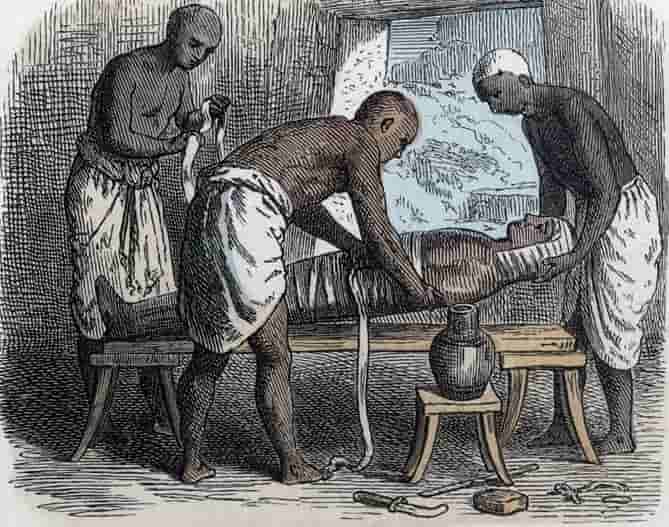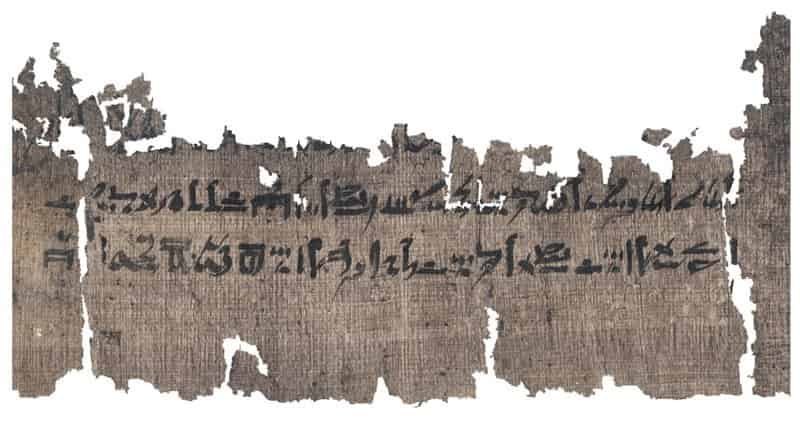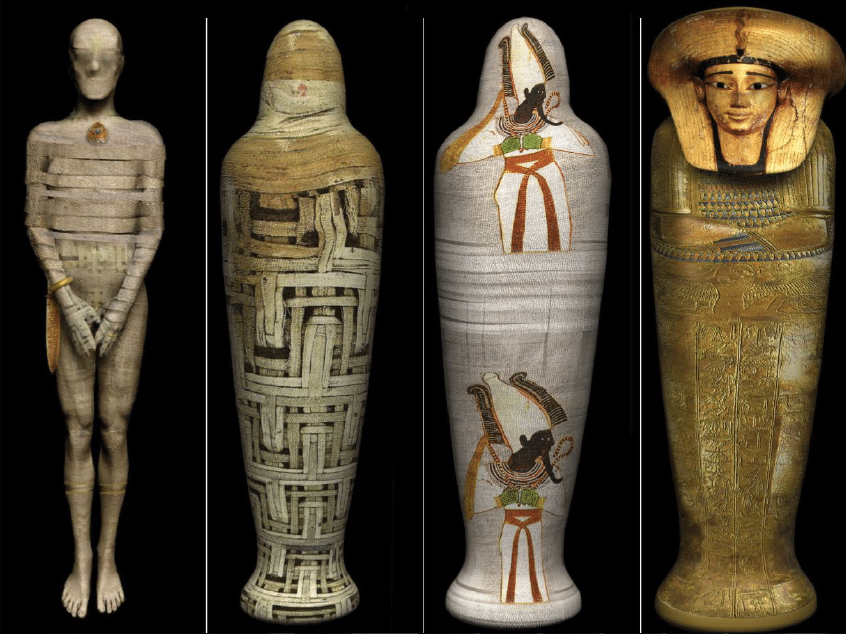
Thanks to the Papyrus Louvre-Carlsberg we now know how the mummification of the face was carried out.
A researcher at the University of Copenhagen has studied a short mummification manual discovered in the Papyrus Louvre-Carlsberg that contains some techniques previously unpublished, such as the treatment of the deceased’s face.
In ancient Egypt, embalming was considered a sacred art and its knowledge was the heritage of very few. Most Egyptologists believe that the secrets of mummification were probably transmitted by oral tradition from one embalmer to another, so the written evidence on the techniques used is rather scarce.
In fact, until now, researchers had only managed to identify two texts that dealt with the mummification process. That is why the surprise jumped when discovering a short manual on embalming during the study of an ancient medical text, the Papyrus Louvre-Carlsberg.
This papyrus, of which several sections are missing, is known by this name since at some point it was divided into two halves: one of them ended up in the Louvre Museum in Paris and the other is part of the papyrus collection of the University of Copenhagen. Before, the two parts of the papyrus belonged to two private collectors.
The six-meter-long papyrus is dated to around 1450 BC, which means it predates the only two known examples of embalming texts by more than a thousand years.
Most of the Louvre-Carlsberg Papyrus, which is the second longest surviving medical papyrus from ancient Egypt, deals with medicinal herbs and skin diseases.
Specifically, it contains the oldest known herbal treatise, providing descriptions of the appearance, habitat, uses, and religious significance of a divine plant and its seed, as well as an extensive treatise on inflammatory dermatological diseases, which were considered diseases sent by the lunar god Khonsu.

Fragment of the Carlsberg Papyrus.
Mummification: Face Treatment
The mummification manual that contains the Louvre-Carlsberg Papyrus has just been published by the Egyptologist Sofie Schiødt, from the University of Copenhagen, who has studied it while preparing her doctoral thesis.
“Many descriptions of embalming techniques that we find on this papyrus were left out of the later two manuals, and the descriptions are extremely detailed. The text reads as a reminder, so the readers must have been specialists who needed that some details were refreshed, such as recipes for ointments and the use of various types of bandages. Some of the simpler processes, such as drying the body with natron, have been omitted”, explains the researcher.
“One of the new and exciting pieces of information that this manual provides us concerns the procedure for embalming the deceased’s face. It provides a list of ingredients to make a mixture that consists mainly of aromatic substances of plant origin and binders that are cooked in a liquid that embalmers covered a piece of red linen with, then the soaked red linen was applied to the deceased’s face to enclose it in a kind of protective ‘cocoon’ of aromatic material that also possessed antibacterial properties. This process was repeated at four-day intervals, “adds Schiødt.
Although this procedure has not been identified before, Egyptologists have examined several mummies from the same period in which the manual was written, whose faces were covered with cloth and resins. According to the researcher, this would fit perfectly with the procedure described in this manuscript.
A Trip to Eternity
The importance of the manual containing the Louvre-Carlsberg Papyrus in the reconstruction of the embalming process is that the specification of this technique is divided into four-day intervals. Thus, every four days, the embalmers worked hard on the mummy.
“The mummy was carried in a ritual procession throughout the process to celebrate the advances in the restoration of the body’s integrity of the deceased. In total, seventeen processions were carried out during the embalming process. And every four days, the body was covered with a cloth and straw dipped in aromatic substances to keep insects and scavengers away “, explains Sofie Schiødt.
How was mummification carried out?
Although there were different techniques depending on the period and the social class of the deceased, according to Sofie Schiødt, embalming in ancient Egypt was normally carried out inside a mummification tent built for the purpose near the tomb, and lasted 70 days.
The 70 days were divided into two phases: a 35-day drying period and a 35-day wrapping period. During the drying phase, the body was treated with dry natron both inside and out.
The embalming of the face described in the Papyrus Louvre-Carlsberg was carried out in this phase. The entire 70-day embalming process was divided into four-day intervals, and the mummy was considered finished on the 68th day.
Afterwards, it was placed inside its coffin, after which the last days were devoted to carrying out activities rituals that would allow the deceased to enjoy his existence in the afterlife.
There are still many secrets to discover about the fascinating technique of mummification in Ancient Egypt.

News
Unveiling the Ingenious Engineering of the Inca Civilization: The Mystery of the Drill Holes at the Door of the Moon Temple in Qorikancha – How Were They Made? What Tools Were Used? What Secrets Do They Hold About Inca Technology? And What Does Their Discovery Mean for Our Understanding of Ancient Construction Methods?
In the heart of Cusco, Peru, nestled within the ancient Qorikancha complex, lies a fascinating testament to the advanced engineering prowess of the Inca civilization. Here, archaeologists have uncovered meticulously angled drill holes adorning the stone walls of the Door…
Unveiling the Sun Stone: Aztec Relic from the Reign of Moctezuma II (1502-1520) – What Secrets Does It Hold? How Was It Used? What Symbolism Does It Carry? And What Does Its Discovery Reveal About Aztec Culture?
In the heart of Mexico City, amidst the bustling Plaza Mayor, lies a silent sentinel of ancient wisdom and artistry – the Sun Stone. This awe-inspiring artifact, dating back to the reign of Moctezuma II in the early 16th century,…
Uncovering the Past: Rare 1,000-Year-Old Copper Arrowhead Found – Who Crafted It? What Was Its Purpose? How Did It End Up Preserved for So Long? And What Insights Does It Offer into Ancient Societies?
In the realm of archaeology, every discovery has the potential to shed light on our shared human history. Recently, a remarkable find has captured the attention of researchers and enthusiasts alike – a rare, 1,000-year-old copper arrowhead. This ancient artifact…
Unveiling History: The Discovery of an Old Sword in Wisła, Poland – What Secrets Does It Hold? Who Owned It? How Did It End Up There? And What Does Its Discovery Mean for Our Understanding of the Past?
In a remarkable archaeological find that has captured the imagination of historians and enthusiasts alike, an old sword dating back to the 9th-10th century AD has been unearthed in Wisła (Vistula River) near Włocławek, Poland. This discovery sheds light on the rich…
Unveiling the Hidden Riches: Discovering the Treasure Trove of a Notorious Pirate – Who Was the Pirate? Where Was the Treasure Found? What Historical Insights Does It Reveal? And What Challenges Await Those Who Seek to Uncover Its Secrets?
A group of divers said on May 7 that they had found the treasure of the infamous Scottish pirate William Kidd off the coast of Madagascar. Diver Barry Clifford and his team from Massachusetts – USA went to Madagascar and…
Excavation Update: Archaeologists Unearth Massive Cache of Unopened Sarcophagi Dating Back 2,500 Years at Saqqara – What Secrets Do These Ancient Tombs Hold? How Will They Shed Light on Ancient Egyptian Burial Practices? What Mysteries Await Inside? And Why Were They Buried Untouched for Millennia?
Egypt has unearthed another trove of ancient coffins in the vast Saqqara necropolis south of Cairo, announcing the discovery of more than 80 sarcophagi. The Tourism and Antiquities Ministry said in a statement that archaeologists had found the collection of colourful, sealed caskets which were…
End of content
No more pages to load











